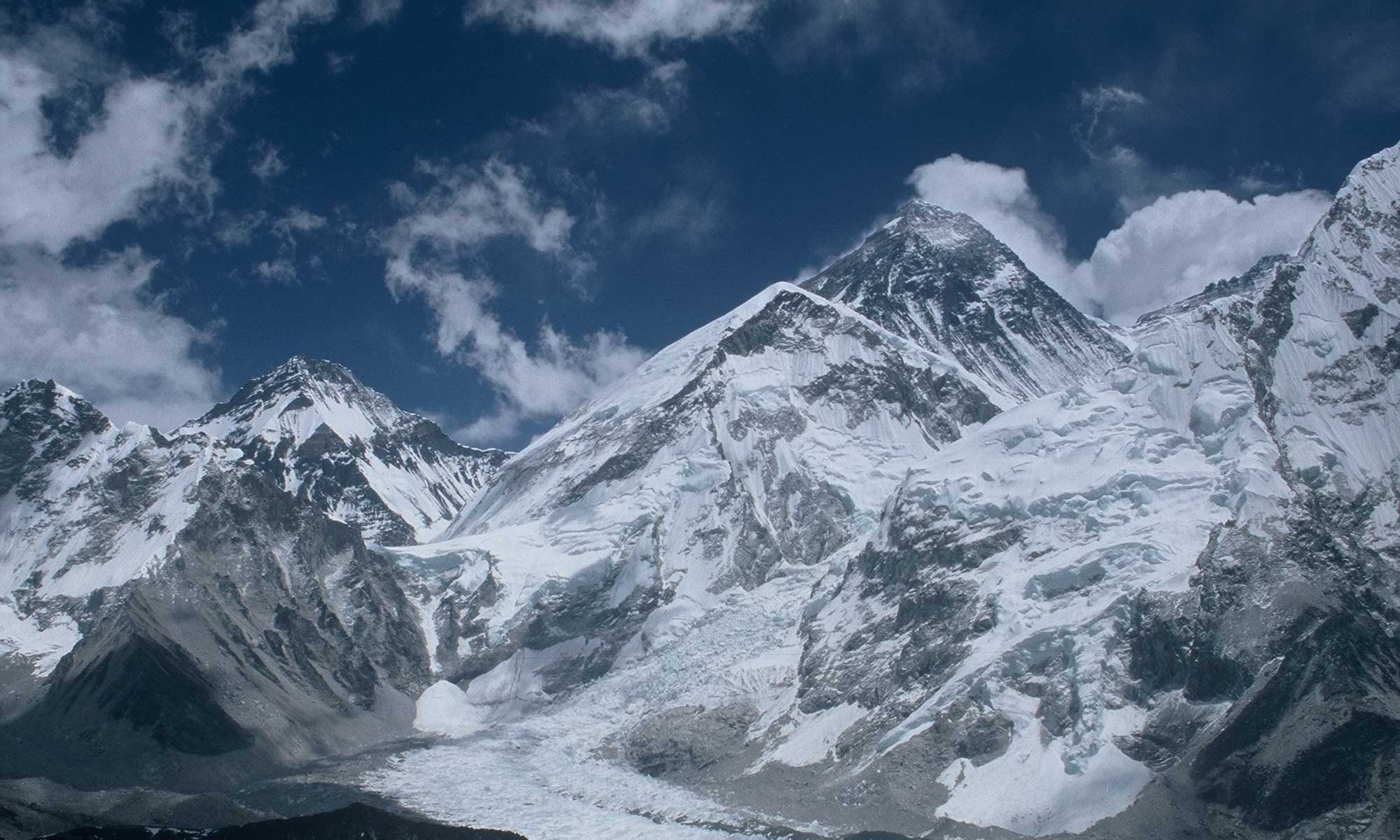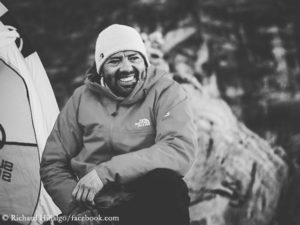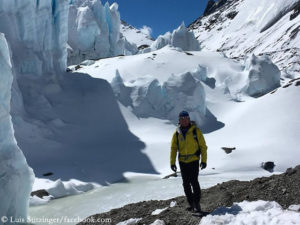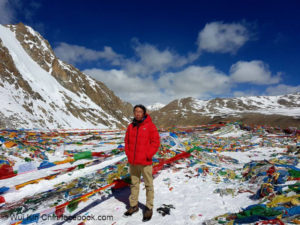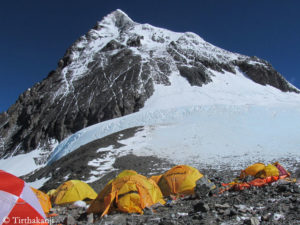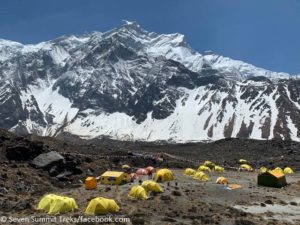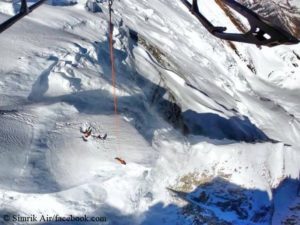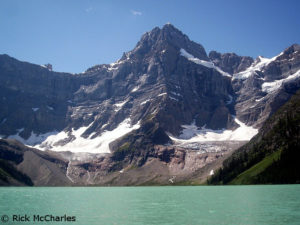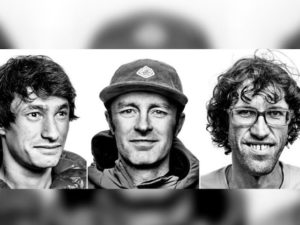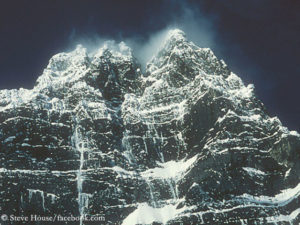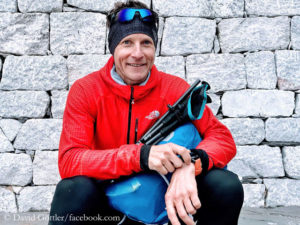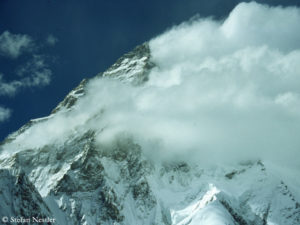Another sad news from the eight-thousanders: Richard Hidalgo, one of South America’s most famous climbers, has died on Makalu. Sherpas of the Nepalese expedition operator “Seven Summit Treks”, who had been fixing ropes on the fifth highest mountain in the world, found the 52-year-old Peruvian dead in his tent in Camp 2 at 6,600 meters. Hidalgo had set himself the goal of climbing all 14 eight-thousanders without bottled oxygen by 2021 – the year in which Peru will celebrate the 200th anniversary of independence.
Continue reading “Richard Hidalgo dies on Makalu”Luis Stitzinger: “Just now standstill on Everest”
The outer bands of the cyclone “Fani” have also reached Mount Everest. Strong winds and snowfall is reported from both sides of the highest mountain on earth. The expedition teams have no choice but to sit out the bad weather in the base camp. Luis Stitzinger leads a group of the Austrian expedition operator “Furtenbach Adventures” on the Tibetan north side of Everest. I have contacted the 50-year-old German, who has already scaled eight eight-thousanders, all of them without bottled oxygen.
Luis, you were on the North Col at 7,000 meters for the first time this season. What are the conditions on the mountain like?
Continue reading “Luis Stitzinger: “Just now standstill on Everest””After rescue from Annapurna: Mountaineer Wui Kin Chin is dead
In the end, all the effort was in vain: this of Nima Tshering Sherpa, who had left his oxygen bottle to his client in the death zone and had waited with him for hours; the effort of the four-man rescue team that had ascended to him, provided him with first aid and then brought him down the mountain so far that he could be flown out; that of the helicopter crew, who had first searched for him in an extremely risky manoeuvre and later flown him out from the flanks of the mountain on a long rescue line; the effort of the doctors in Kathmandu and then in Singapore, who fought for his life.
Continue reading “After rescue from Annapurna: Mountaineer Wui Kin Chin is dead”Fixed ropes up to Everest South Col
Slowly but surely the fixed-ropes snake winds its way towards the summit of Mount Everest. The expedition operator “Seven Summit Treks” let us know today via Facebook that the ropes on the Nepalese south side of the mountain have been completely fixed up to the South Col at 7,900 meters. On the north side, the Tibetan rope-fixing team is working their way up above the 7,000-meter-high North Col towards the North-East Ridge. For the weekend, heavy snowfall is expected on the highest mountain on earth, so the work of the rope-fixing teams on both sides of Everest is about to rest for a few days.
Continue reading “Fixed ropes up to Everest South Col”Dispute over the rescue operation on Annapurna
Mountains are rarely only black and white, neither is reality. Even if we would prefer to see them all black or white, they remain grey in many places – depending on which glasses we look through, more black or white. For days there has been a lot of discussion in the mountaineering scene about the rescue of the Malaysian climber Wui Kin Chin from high altitude on the eight-thousander Annapurna. The 49-year-old is now being treated in a hospital in Singapore. Even though he seems to be doing better, his condition yesterday was still described as serious. According to the doctors, the frostbite he has suffered on his hands and feet during more than 40 hours at 7,500 meters is massive. The fact that Chin survived is almost a small miracle.
Continue reading “Dispute over the rescue operation on Annapurna”Rescue on Annapurna: Miracle with question marks
Many call it the “little miracle” on Annapurna. For more than 43 hours, Malaysian mountaineer Wui Kin Chin survived at an altitude of 7,500 meters – left alone, without a tent, without bottled oxygen, without water. On Thursday, he was discovered by helicopter during a search flight. A four-man Nepalese rescue team – Nirmal Purja, Mingma David Sherpa, Galgen Sherpa and Gesman Tamang – was dropped at Camp 3 at 6,500 meters, climbed up to Chin in strong winds, provided first aid and then took him down to Camp 3 until late in the night.
From there, the 49-year-old was flown yesterday to a hospital in Kathmandu after a stopover at base camp. According to the doctors, he arrived at the hospital in a critical condition, with low heart rate and body temperature and frostbite on his hands and feet. The fact that he is still alive is due to the great performance of the rescue team, including the helicopter pilots of “Simrik Air”.
Continue reading “Rescue on Annapurna: Miracle with question marks”Successful rescue operation on Annapurna
Relief on the eight-thousander Annapurna: Wui Kin Chin from Malaysia, who was missing after summiting the 8091-meter-high mountain on Tuesday, is alive. A Nepalese rescue team found the 49-year-old mountaineer at an altitude of 7,500 meters and now takes him further down. Their goal is to reach Camp 3 at 6,500 meters. From there the Malaysian is to be flown out by helicopter tomorrow.
Continue reading “Successful rescue operation on Annapurna”Summit successes reported from Annapurna
From the west of Nepal, the first eight-thousander summit successes of the spring season are reported. The Nepalese expedition operator “Seven Summit Treks” announced on Facebook that 31 mountaineers had reached the highest point at 8,091 meters today. Among the 14 foreign climbers mentioned is the Turk Tunc Findik. If the summit success of the 47-year-old is confirmed, it would be his twelfth eight-thousander. Only Nanga Parbat and the Gasherbrum I are then still missing in his collection.
Continue reading “Summit successes reported from Annapurna”Lama, Auer, and Roskelley: Avalanche death on descent
Hope had already been gone before, but now it is sad certainty: The two Austrians David Lama (28 years old) and Hansjörg Auer (35) as well as the US-American Jess Roskelley (36) died in an avalanche on Howse Peak. On Sunday, a rescue team found the bodies of the three top climbers at the foot of the 3,295 meter high mountain in the Canadian Rocky Mountains. “The avalanche conditions were hazardous to the rescue team, so a specially trained avalanche dog was used to locate the climbers,” says a statement by the Roskelley family.
Continue reading “Lama, Auer, and Roskelley: Avalanche death on descent”Happy Easter!
Mourning for extreme climbers Lama, Auer and Roskelley
Officially David Lama, Hansjörg Auer and Jess Roskelley are still missing. But there is no hope that the three climbers survived the avalanche on the 3,295-meter-high Howse Peak. The still high avalanche danger in the Canadian Rocky Mountains has not yet allowed a recovery. Parks Canada, the national park authority of the Canadian government, has closed the area.
The shock is deep in the mountaineering scene. “Three of the best alpinists in the world lost in one unfortunate accident”, writes US climber Alex Honnold. “The three missing mountaineers were no doubt a great asset of our community,” adds Pakistani top mountaineer Muhammad Ali “Sadpara”, who is currently en route on the eight-thousander Makalu in Nepal. “The gap they created can never be bridged.”
Continue reading “Mourning for extreme climbers Lama, Auer and Roskelley”Avalanche in Canada: Almost no hope for Lama, Auer and Roskelley anymore
The international mountaineering scene is shocked. The top climbers David Lama and Hansjörg Auer from Austria and Jess Roskelley from the USA most probably died in an avalanche accident on the 3,295-meter-high Howse Peak in the Canadian Rocky Mountains. “Based on the assessment of the scene, all three members of the party are presumed to be deceased,” Parks Canada, the national park authority of the Canadian government, announced. Equipment had been discovered in a huge avalanche cone during a reconnaissance flight, it said: “Further investigation is underway but recovery efforts are not currently possible due to additional avalanches and dangerous conditions at the scene.”
Continue reading “Avalanche in Canada: Almost no hope for Lama, Auer and Roskelley anymore”Lama, Auer and Roskelley missed in Canada
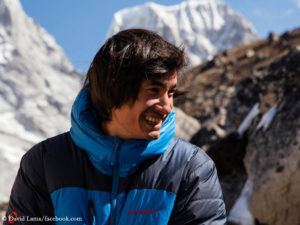
The international mountaineering and climbing scene fears for three of their best. According to media reports from Austria and Italy, the two Austrians David Lama and Hansjörg Auer as well as the American Jess Roskelley are said to have been caught by an avalanche while climbing in western Canada. Official information is not yet available.
The “Tiroler Tageszeitung” from Austria reported that the huge avalanche cone had already been searched yesterday, Wednesday, by rescue planes – without success. The “Kronenzeitung”, from Austria too, reported that the 35-year-old Auer had died in the accident, citing its own information. David Lama’s manager announced a statement by the family on the 28-year-old’s homepage, but without naming a time.
Continue reading “Lama, Auer and Roskelley missed in Canada”David Göttler will try Everest without bottled oxygen
It could be another record season on Mount Everest. Until last Tuesday, the Ministry of Tourism in Kathmandu alone issued 374 climbing permits for the south side of the world’s highest mountain. On the north side, the Chinese-Tibetan authorities have limited the number of climbing permits to 300 this spring. Last year, according to the mountaineering chronicle “Himalayan Database”, 802 climbers reached the summit at 8,850 meters, only one without bottled oxygen: 32-year-old Sonam Finju Sherpa.
This season, too, only a few mountaineers will try to scale Everest without breathing mask. One of them will be David Göttler, who arrived in Kathmandu today. “Nowadays many people think it’s easy because there’s no differentiation between oxygen aspirants and the few without,” the 40-year-old German. “But to make it to the top ‘without diving equipment’ is still not easy. Everything has to fit. And so it would also mean an awful lot to me to reach the summit.”
Continue reading “David Göttler will try Everest without bottled oxygen”Where to with the dirty K2 laundry?
It’s quite normal that mountaineers return from an expedition with dirty clothes. After all, it’s important to travel with as little weight as possible. And that’s why, after the trip, the strong smell in the laundry room at home from clothes worn too long is simply part of it. But is it really necessary to wash your dirty laundry in public? For days, the members of the two recently failed K2 winter expeditions have been engaged in a media exchange of blows. With the meanwhile almost usual echo on the social networks – from people who weren’t there, but think they have to put their oar in.
Continue reading “Where to with the dirty K2 laundry?”